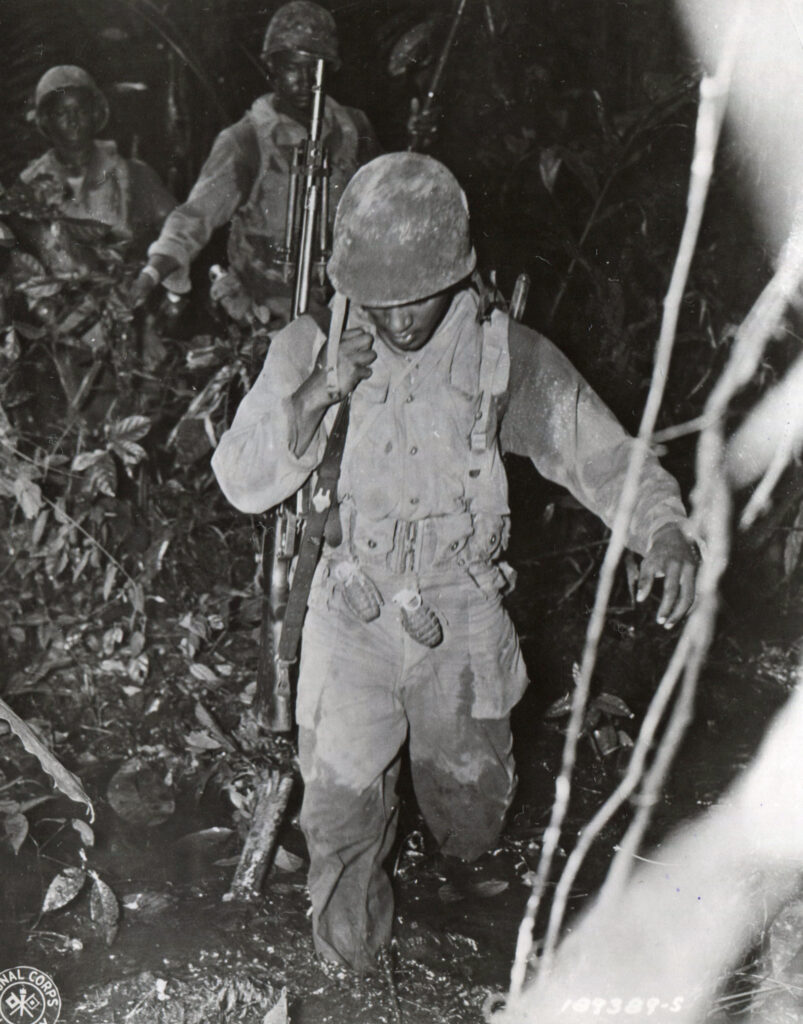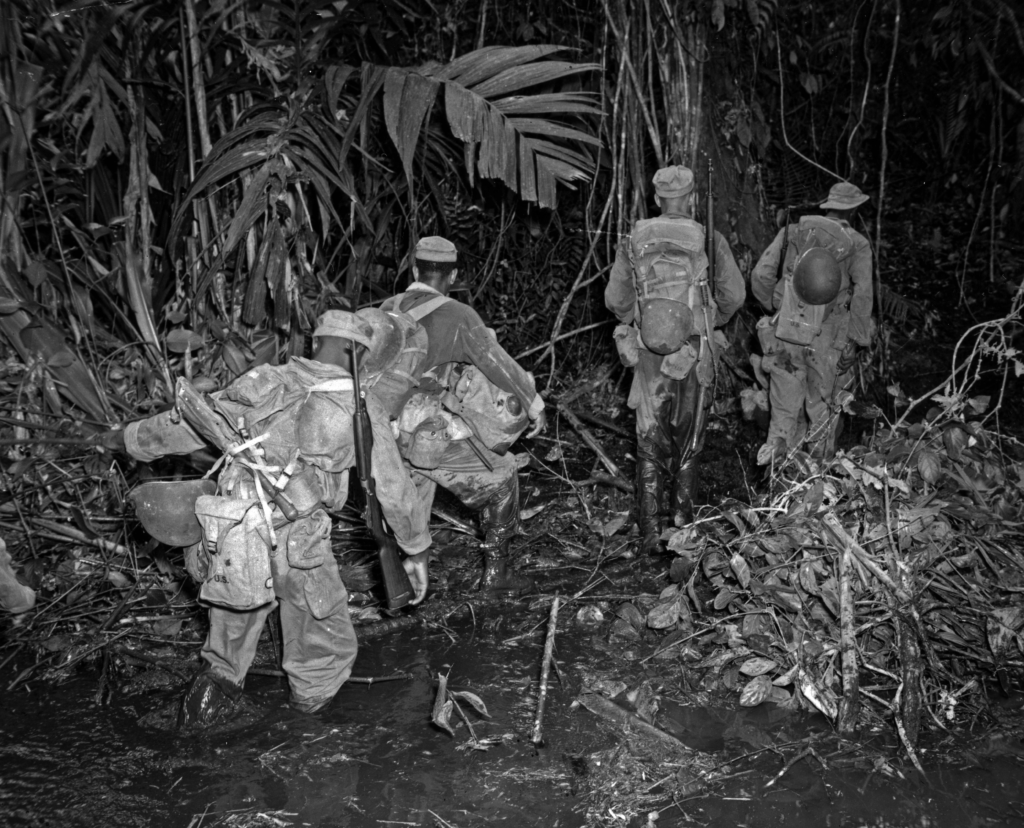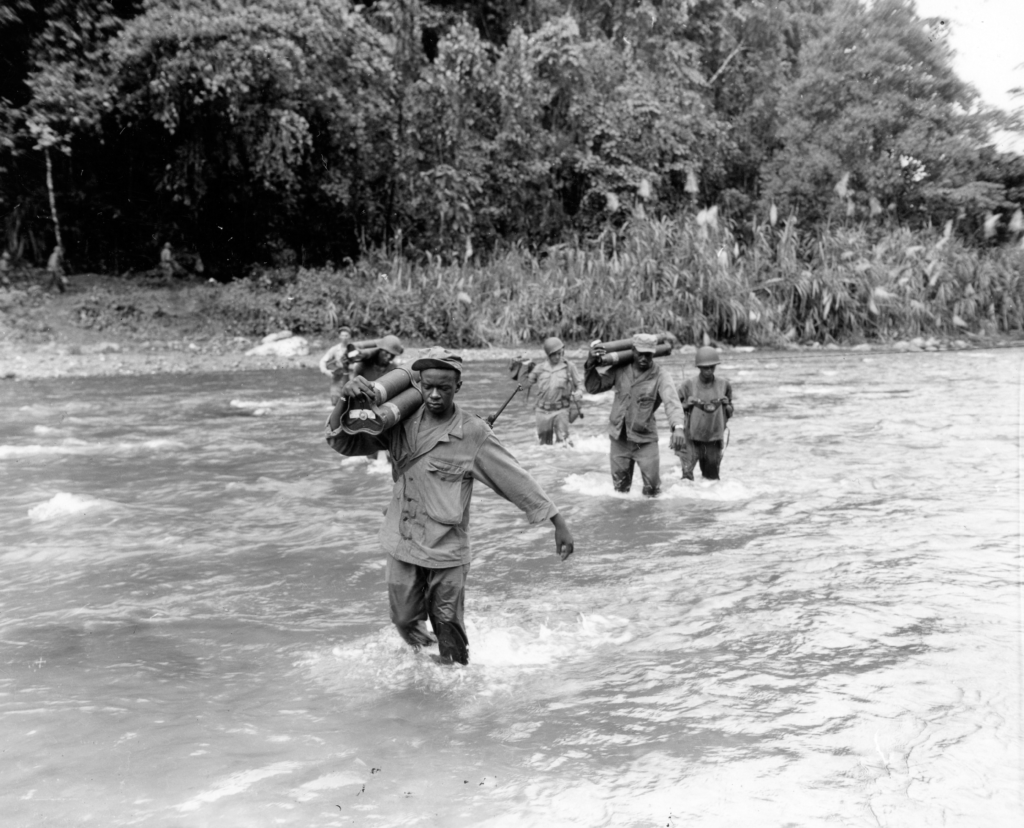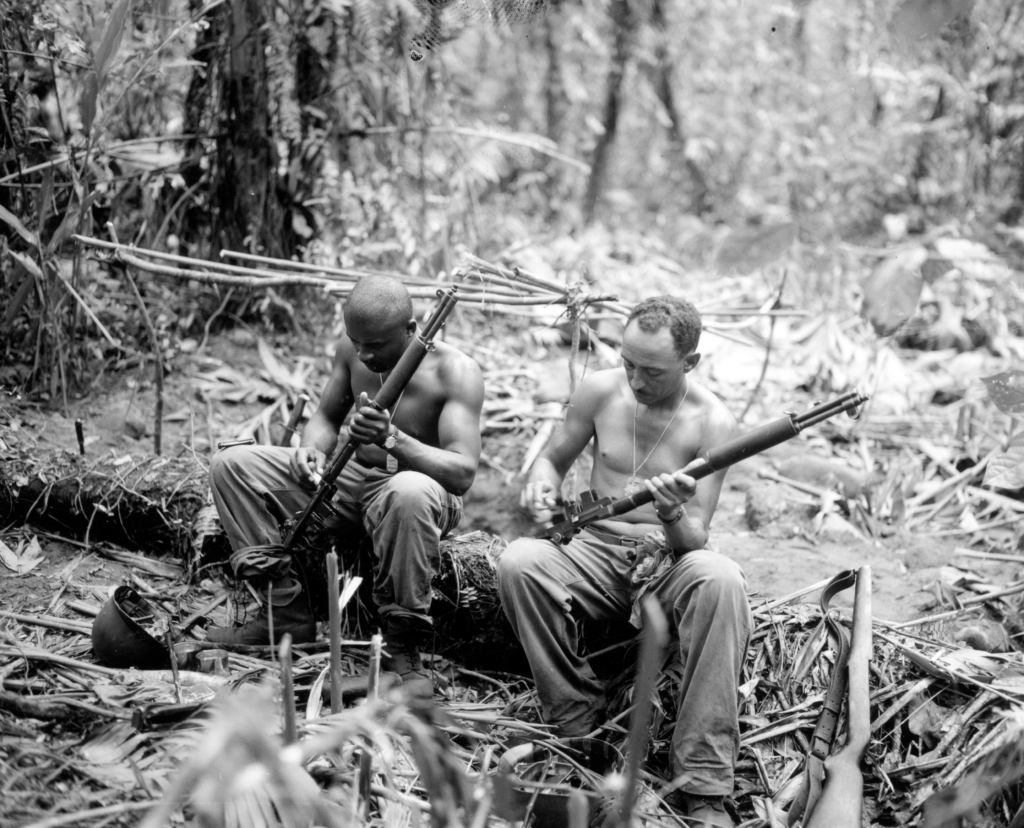

Prior to the deployment of the 93rd Infantry Division in 1944, American generals did not want the 93rd Division involved with the European theaters. Therefore, 93rd would be sent to the South Pacific in order to relieve a combat division for the planned invasion of the Philippines.
In February 1944, they began their mission in the Solomon Islands, a chain of islands that served as a staging area for the anticipated retaking of the Philippines and the site of Allied armed conflict since 1942. Their service consisted of building up of the infrastructure, assisting in the handling of essential supplies, guarding the bases, conducting training in jungle warfare and conducting mop-up operations against the Japanese forces that remained on these isolated island outposts.
Regiments of the 93rd Division were scattered throughout the Solomon Islands. One regiment, 25th Infantry Regiment (now part of the 25th Regimental Combat Team) were sent to Bougainville, Papua Guinea, to fight the remaining Imperial Japanese forces alongside the Americal Division and Commonwealth soldiers from Australia, New Zealand and Fiji.
In April 1944, the 25th RCT was the first African American combat division raised in the US Army during World War II to fire shots at hostile forces. Due to this, the experiences of the 25th RCT on Bougainville was followed closely by many including the upper echelons of the US military and government as well as the Black press.
(Document courtesy of the National Archives)
OUTGOING CLASSIFIED MESSAGE
18 March 1944
To:: LT.GEN. M.F. HARMON
In the use of the Ninety Third Division or its elements the
first time in action, the Secretary of War and I both feel it essential that it not repeat not be committed prior to adequate preparation on the part of the unit or units involved.
(For Harmon’s eyes only from Marshall). The first reports of its conduct in action undoubtedly will be headlined in this country. It is therefore important that news releases and reports from the theater on the conduct of these troops be strictly factual. The War Department has been under constant pressure for alleged failure to utilize negro soldiers in a combat capacity. We are very desirous of employing them as soon as practicable and they should have a careful test to determine their battle dependability. (In order that the Secretary of War can be kept fully informed on this question it is desired that you submit a report on the conduct of the troops of this division soon after their initial entry into battle and thereafter from time to time should there be anything in their conduct under fire that warrants comment.
H.M. Pasco,
Colonel, General Staff, Secretary
On April 5, 1944, Company K (Reinforced) of the 3rd Battalion, 25th Regimental Combat Team was sent to the area around Hill 250 on Bougainville to ambush the Imperial Japanese forces that would traverse the trails on the island and probe allied defense lines. For context, the 3rd Battalion of the 25th Regimental Combat Team had the least amount of jungle training in comparison to the 1st and 2nd Battalions. In spite of this, Company K, then under the command of the 164th Infantry Regiment, Americal Division was ordered to conduct the operation.
Forward observers from the 593rd Field Artillery Battalion, and a machine gun platoon from Company M were attached to augment Company K to complete its mission. In addition, some soldiers from the 161st Signal Photographic Company were sent along to document this operation. The mission was going smoothly until April 7th when Company K came upon an abandoned Japanese field hospital.
What happened next varies depending on the accounts, but according to the dominant theory, once the individual platoons spread out to complete their objectives, they came under fire from Japanese troops that were in the area. All the platoons engaged and returned fire. However, the concentration of fire from Imperial Japanese forces forced one of the platoons to fall back. This in turn left the other platoons exposed to flanking fire and created confusion.The fall back order to establish a secondary line of defense given by the company commander led to mass confusion within the company.
25th RCT in Action Bougainville Easter 1944 (Newsreel courtesy of the National Archives)
The confusion subsided once artillery fire from the 593rd was called in. Afterward, the platoons of Company K were able to pull back to the company’s perimeter. Official records dispute the number of casualties. The Historical Journal, an official report of the 25th Infantry Regiment written on July 10, 1944, stated the total number of casualties for the skirmish was thirteen men killed in action including an officer and a medic and seventeen men wounded. However, the Divisional Record of Events published in June/July 1944 mentioned that there were eighteen men in total killed in action including an officer and seven wounded. Regardless of the actual numbers, this skirmish would prove to be the 93rd Infantry Division’s bloodiest battle in World War II. (United States Army, 1944)
593rd FA_25th RCT doing fire missions in the evening Bougainville Easter 1944 (Newsreel courtesy of the National Archives)
“Most every man in my outfit could handle all the infantry weapons,” [Pvt. Luther J. McNair] said, in an interview at Letterman General Hospital, San Francisco, released today by the War Department. “For months before we went overseas we had been through intensive maneuvers, and we were well trained and tough.”
“We were ready when we went overseas,” he said, “and we didn’t waste much time going into action. The division split up after we landed in Guadalcanal last February, and my regiment was fighting on Bougainville within a month.
“That first battle, for Hill 260, was some fight, too.”
The chaos and confusion that occurred during the skirmish near Hill 250, resulted in questions about the soldiering abilities of the troops in K Company, as well as the viability of Black soldiers as combat troops overall. As a result, the Americal Division, which at the time was responsible for assisting the the 25th Regimental Combat Team’s transition to jungle combat, launched investigations to determine who was at fault and what went wrong.
The mostly White officer corps blamed the breakdown in communication on the Black enlisted soldiers, arguing that this was the first time many of the soldiers were seeing combat and the common misconception that Black soldiers are skittish under fire and retreat upon contact with the enemy.
The Black enlisted and junior officers blamed the confusion that occurred that day on the miscommunication from the officers and Company Commander. The officers and military leaders felt their opinions were justified because of the perceived failures of K Company in the engagement on Hill 250. Ultimately, the investigation blamed some of the junior officers, resulting in reassignments and a court-martial. The soldiers of the 93rd Infantry Division and Black combat troops continued to battle against the negative perception generated by ranking officers.




Tuesday–Saturday
10AM–4PM
Thursday
10AM–5PM
1PM – 5PM (Free Admission)
Sunday
Closed
Monday
Closed



